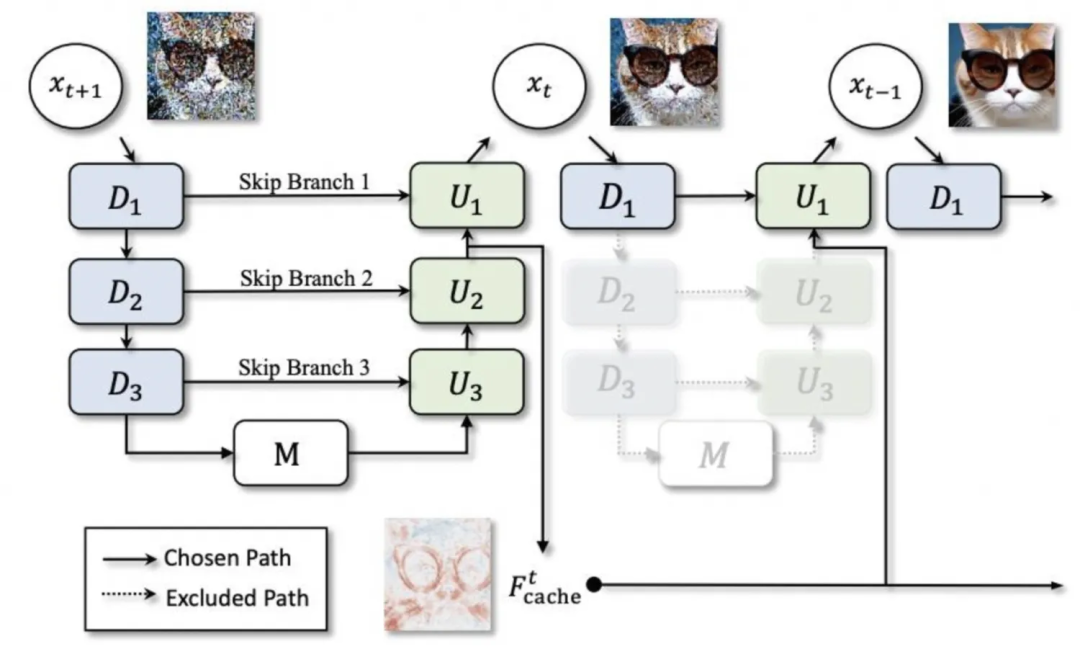

The current mainstream acceleration ideas include operator optimization, model compilation, model caching, model distillation, etc. The following will briefly introduce several representative open source solutions used in testing.
▐Operator optimization: FlashAttention2
▐Model compilation: oneflow/stable-fast
oneflow accelerates model inference by compiling the model into a static graph and combining it with oneflow.nn.Graph's built-in operator fusion and other acceleration strategies. The advantage is that the basic SD model only needs one line of compiled code to complete the acceleration, the acceleration effect is obvious, the difference in the generation effect is small, it can be used in combination with other acceleration solutions (such as deepcache), and the official update frequency is high. The shortcomings will be discussed later.
Stable-fast is also an acceleration library based on model compilation, and combines a series of operator fusion acceleration methods, but its performance optimization relies on tools such as xformer, triton, and torch.jit.
▐Model caching: deepcache

▐Model distillation: lcm-lora
Combining lcm (Latent Consistency Model) and lora, lcm will distill the entire sd model to achieve few-step reasoning, while lcm-lora uses the form of lora to only optimize the lora part, which can achieve acceleration. Can also be combined directly with regular lora usage.

SD1.5 acceleration test
▐Test environment
▐Test results
-
By comparing the generated images with a fixed seed, we can find that oneflow compilation can reduce rt by more than 40% with almost no loss in accuracy. However, when using a new pipeline to generate images for the first time, it takes tens of seconds of compilation time as a warmup. -
Deepcache can reduce rt by an additional 15% to 25% on this basis, but at the same time, as the cache interval increases, the difference in generation effects becomes more and more obvious. -
oneflow is also effective for the SD1.5 model using controlnet -
stable-fast relies heavily on external packages, and is prone to various version problems and external tool errors. Similar to oneflow, it takes a certain amount of compilation time to generate images for the first time, and the final acceleration effect is slightly inferior to oneflow.
▐Detailed comparison data
Optimization |
Average generation time (seconds) 512*512,50step |
acceleration effect |
Generate effect 1 |
Generate effect 2 |
Generate effect 3 |
diffusers |
3.3701 |
0 |
|
|
|
diffusers+bf16 |
3.3669 |
≈0 |
|
|
|
diffusers+controlnet |
4.7452 |
|
|||
diffusers+oneflow compilation |
1.9857 |
41.08% |
|
|
|
diffusers+oneflow compilation+controlnet |
2.8017 |
|
|||
diffusers+oneflow compilation+deepcache |
interval=2:1.4581 |
56.73%(15.65%) |
|
|
|
interval=3:1.3027 |
61.35%(20.27%) |
|
|
||
interval=5:1.1583 |
65.63%(24.55%) |
|
|
||
diffusers+sfast |
2.3799 |
29.38% |

▐Test environment
▐Test results
Basic sdxl model:
Under the condition of fixed seed, the sdxl model seems to be more likely to affect the effect of generating images by using different acceleration schemes.
Oneflow can only reduce rt by 24%, but it can still ensure the accuracy of generated images.
deepcache能够提供极其显著的加速,interval为2(即缓存只使用一次)时rt降低42%,interval为5时rt降低69%,但生成图片差异也很明显
lcm-lora显著降低了生图所需步数,能够极大程度地实现推理加速,但在使用预训练权重的情况下,稳定性极差,对步数非常敏感,无法保证稳定产出符合要求的图片
oneflow and deepcache/lcm-lora can be used well together
lora:
After loading lora, the inference speed of diffusers is significantly reduced, and the degree of reduction is related to the type and amount of lora used.
deepcache still works, and there are still accuracy issues, but the difference is not big at lower cache intervals
When using lora, oneflow compilation cannot fix the seed to remain consistent with the original version.
oneflow编译优化了加载lora后的推理速度,加载多个lora时,推理rt与未加载lora时相差不大,加速效果极其显著。例如,同时使用yarn+watercolor两个lora,rt能够降低约65%
oneflow has slightly optimized the loading time of lora, but the setting operation time after loading lora has increased.
▐Detailed comparison data
Optimization |
lora |
Average generation time (seconds) 512*512, 50step |
Lora loading time (seconds) |
lora modification time (seconds) |
Effect 1 |
Effect 2 |
Effect 3 |
diffusers |
none |
4.5713 |
|
||||
yarn |
7.6641 |
13.9235 11.0447 |
0.06~0.09 根据配置的lora数量 |
||||
watercolor |
7.0263 |
||||||
yarn+watercolor |
10.1402 |
|
|||||
diffusers+bf16 |
无 |
4.6610 |
|
||||
yarn |
7.6367 |
12.6095 11.1033 |
0.06~0.09 根据配置的lora数量 |
||||
watercolor |
7.0192 |
||||||
yarn+ watercolor |
10.0729 |
||||||
diffusers+deepcache |
无 |
interval=2:2.6402 |
|
||||
yarn |
interval=2:4.6076 |
||||||
watercolor |
interval=2:4.3953 |
||||||
yarn+ watercolor |
interval=2:5.9759 |
|
|||||
无 |
interval=5: 1.4068 |
|
|||||
yarn |
interval=5:2.7706 |
||||||
watercolor |
interval=5:2.8226 |
||||||
yarn+watercolor |
interval=5:3.4852 |
|
|||||
diffusers+oneflow编译 |
无 |
3.4745 |
|
||||
yarn |
3.5109 |
11.7784 10.3166 |
0.5左右 移除lora 0.17 |
||||
watercolor |
3.5483 |
||||||
yarn+watercolor |
3.5559 |
|
|||||
diffusers+oneflow编译+deepcache |
无 |
interval=2:1.8972 |
|
||||
yarn |
interval=2:1.9149 |
||||||
watercolor |
interval=2:1.9474 |
||||||
yarn+watercolor |
interval=2:1.9647 |
|
|||||
无 |
interval=5:0.9817 |
|
|||||
yarn |
interval=5:0.9915 |
||||||
watercolor |
interval=5:1.0108 |
||||||
yarn+watercolor |
interval=5:1.0107 |
|
|||||
diffusers+lcm-lora |
4step:0.6113 |
||||||
diffusers+oneflow编译+lcm-lora |
4step:0.4488 |

AI试衣业务场景使用了算法在diffusers框架基础上改造的专用pipeline,功能为根据待替换服饰图对原模特图进行换衣,基础模型为SD2.1。
根据调研的结果,deepcache与oneflow是优先考虑的加速方案,同时,由于pytorch版本较低,也可以尝试使用较新版本的pytorch进行加速。
▐ 测试环境
A10 + cu118 + py310 + torch2.0.1 + diffusers0.21.4
图生图(示意图,仅供参考):
待替换服饰 |
原模特图 |
|
|
▐ 测试结果
pytorch2.2版本集成了FlashAttention2,更新版本后,推理加速效果明显
deepcache仍然有效,为了尽量不损失精度,可设置interval为2或3
对于被“魔改”的pipeline和子模型,oneflow的图转换功能无法处理部分操作,如使用闭包函数替换forward、使用布尔索引等,而且很多错误原因较难通过报错信息来定位。在进行详细的排查之后,我们尝试了改造原模型代码,对其中不被支持的操作进行替换,虽然成功地在没有影响常规生成效果的前提下完成了改造,通过了oneflow编译,但编译后的生成效果很差,可以看出oneflow对pytorch的支持仍然不够完善
最终采取pytorch2.2.1+deepcache的结合作为加速方案,能够实现rt降低40%~50%、生成效果基本一致且不需要过多改动原服务代码
▐ 详细对比数据
优化方法 |
平均生成耗时(秒) 576*768,25step |
生成效果 |
diffusers |
22.7289 |
|
diffusers+torch2.2.1 |
15.5341 |
|
diffusers+torch2.2.1+deepcache |
11.7734 |
|
diffusers+oneflow编译 |
17.5857 |
|
diffusers+deepcache |
interval=2:18.0031 |
|
interval=3:16.5286 |
|
|
interval=5:15.0359 |
|

目前市面上有很多非常好用的开源模型加速工具,pytorch官方也不断将各种广泛采纳的优化技术整合到最新的版本中。
我们在初期的调研与测试环节尝试了很多加速方案,在排除了部分优化效果不明显、限制较大或效果不稳定的加速方法之后,初步认为deepcache和oneflow是多数情况下的较优解。
但在解决实际线上服务的加速问题时,oneflow表现不太令人满意,虽然oneflow团队针对SD系列模型开发了专用的加速工具包onediff,且一直保持高更新频率,但当前版本的onediff仍存在不小的限制。
如果使用的SD pipeline没有对unet的各种子模块进行复杂修改,oneflow仍然值得尝试;否则,确保pytorch版本为最新的稳定版本以及适度使用deepcache可能是更省心且有效的选择。

相关资料
FlashAttention:
https://github.com/Dao-AILab/flash-attention
https://courses.cs.washington.edu/courses/cse599m/23sp/notes/flashattn.pdf
oneflow
https://github.com/Oneflow-Inc/oneflow
https://github.com/siliconflow/onediff
stable-fast
https://github.com/chengzeyi/stable-fast
deepcache
https://github.com/horseee/DeepCache
lcm-lora
https://latent-consistency-models.github.io/
pytorch 2.2
https://pytorch.org/blog/pytorch2-2/

我们是淘天集团内容技术AI工程团队,通过搭建完善的算法工程化一站式平台,辅助上千个淘宝图文、视频、直播等泛内容领域算法的工程落地、部署和优化,承接每日上亿级别的数字内容数据,支撑并推动AI技术在淘宝内容社交生态中的广泛应用。
本文分享自微信公众号 - 大淘宝技术(AlibabaMTT)。
如有侵权,请联系 [email protected] 删除。
本文参与“OSC源创计划”,欢迎正在阅读的你也加入,一起分享。




































